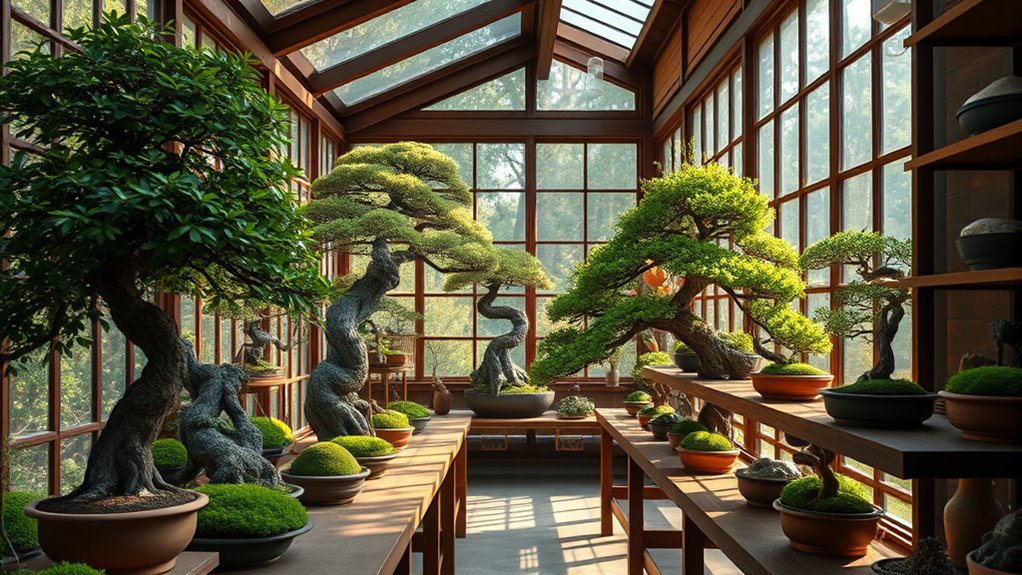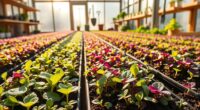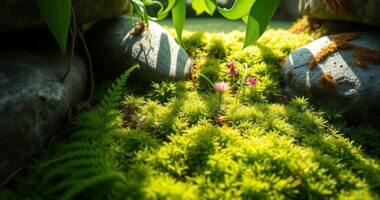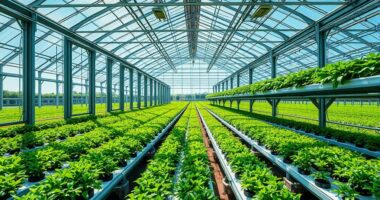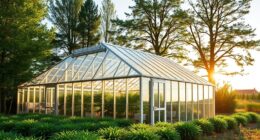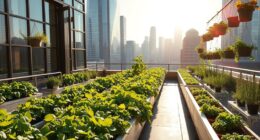I've found six fantastic bonsai greenhouse designs that can truly elevate your gardening game! First, contemplate building your own greenhouse tailored to your space and preferences. The VEIKOU 8 x 14 features durable materials and adjustable vents. A sturdy 6×12 FT greenhouse kit offers easy assembly, while the Macrout Cold Frame comes with adjustable shelves for added flexibility. Each design has unique benefits to enhance your bonsai cultivation. Stick around to discover what factors to contemplate when choosing the perfect greenhouse!
Key Takeaways
- Select a durable aluminum frame with 4mm polycarbonate panels for optimal light transmission and thermal insulation in your bonsai greenhouse design.
- Incorporate adjustable shelves to maximize vertical space and accommodate various bonsai sizes, promoting healthy growth.
- Ensure proper ventilation with adjustable roof vents to prevent overheating and humidity-related issues for your bonsai plants.
- Choose a design with a polished wood finish for aesthetic appeal while ensuring the wood is treated for moisture resistance.
- Consider a lockable door feature for enhanced security, safeguarding your bonsai collection from pests and theft.
How to Build Your Own Greenhouse: Designs and Plans
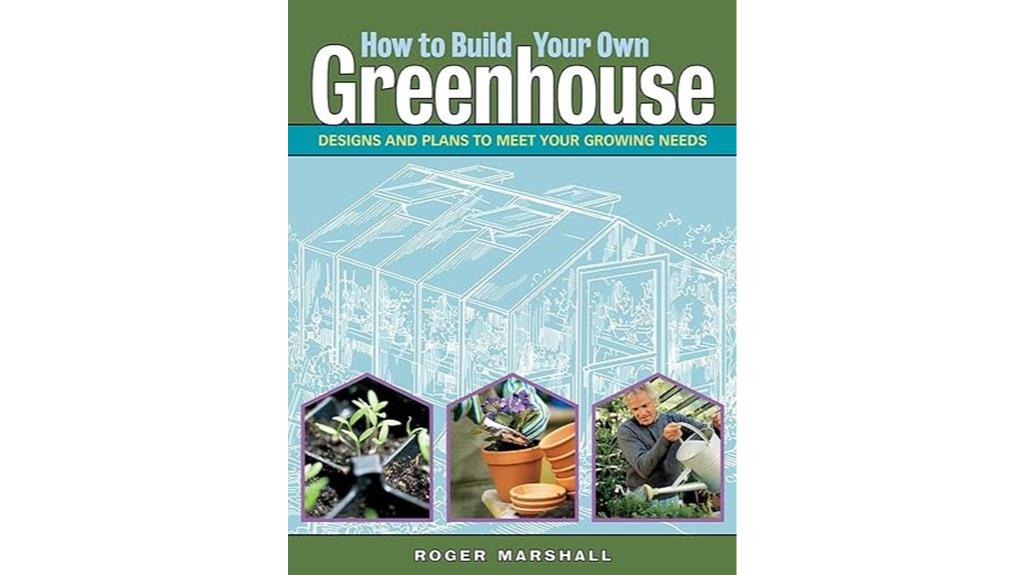
If you're a DIY enthusiast looking to create a greenhouse tailored specifically for bonsai cultivation, then "How to Build Your Own Greenhouse: Designs and Plans" is the perfect choice for you. This thorough guide offers valuable insights into various materials and structures, ensuring your bonsai thrive in the right environment. It's designed for everyone, even if you've never built anything before. I found the clear illustrations and practical advice incredibly helpful when discussing ideas with my architect. While it touches on specialized topics, it primarily focuses on general greenhouse design, making it a must-have for any serious gardener.
Best For: DIY enthusiasts looking to build a greenhouse tailored for bonsai cultivation, regardless of their prior construction experience.
Pros:
- Comprehensive insights into various materials and structures suitable for bonsai.
- Clear illustrations and practical advice facilitate effective communication with architects.
- Ideal for serious gardeners seeking to create a thriving environment for their plants.
Cons:
- Primarily focuses on general greenhouse design, offering limited specialized information on topics like aquaponics.
- May overwhelm beginners seeking only basic greenhouse structures.
- Readers looking for highly specialized designs might need to consult additional resources.
GREENHOUSE GARDENING FOR BEGINNERS: Complete Guide to Growing Vegetables and Fruits
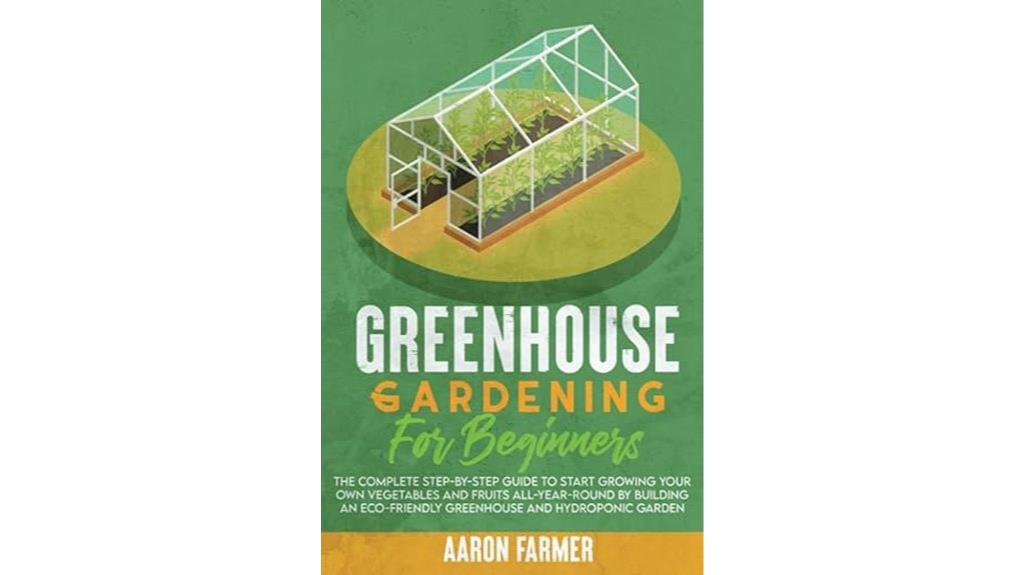
For anyone just starting their journey into greenhouse gardening, "GREENHOUSE GARDENING FOR BEGINNERS" is an invaluable resource. It breaks down everything I needed to know about setting up and maintaining a greenhouse, even as a novice. The book explains how to choose the right structure and offers practical tips for growing vegetables and fruits while avoiding common pitfalls. Although some parts felt too basic, it provided a solid foundation. I found the crop guides particularly helpful. Just keep in mind, it might not explore deeply enough for more experienced gardeners, but it's perfect for beginners like me.
Best For: Beginners in greenhouse gardening who are looking for a straightforward and accessible guide to setting up and maintaining their first greenhouse.
Pros:
- Provides clear and simple instructions for greenhouse setup and maintenance.
- Includes practical tips for growing vegetables and fruits while avoiding common mistakes.
- Features detailed crop guides for popular greenhouse plants, making it easier for beginners to choose what to grow.
Cons:
- Some readers may find the content too basic and lacking in depth for more experienced gardeners.
- The book has been criticized for poor proofreading and the presence of nonsensical statements.
- Limited diagrams and visuals may make it harder for visual learners to fully grasp certain concepts.
Bonsai: The Complete Step-by-Step Guide for Beginners
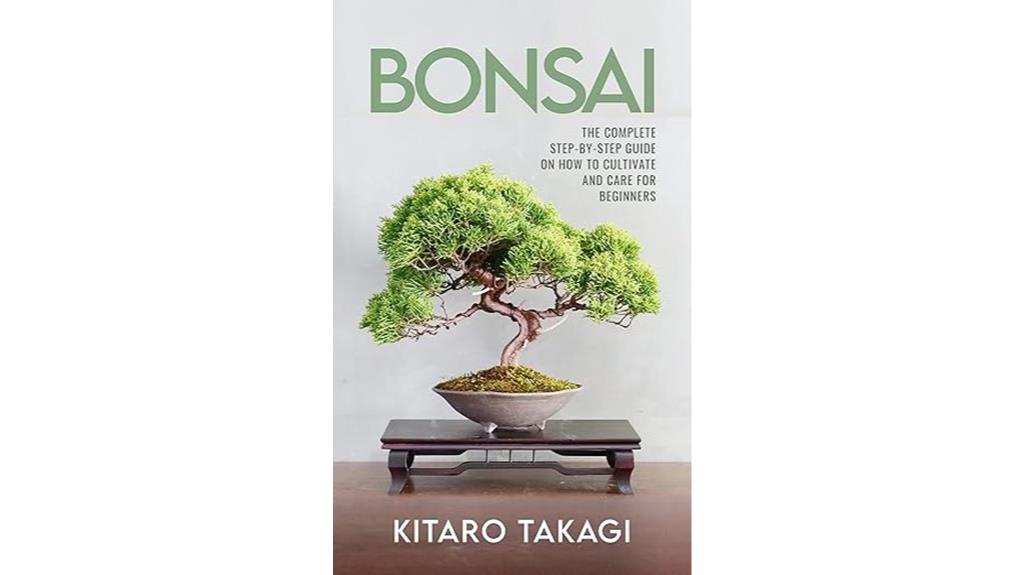
"Bonsai: The Complete Step-by-Step Guide for Beginners" is an excellent choice for anyone just starting their bonsai journey. Written by Kitaro Takagi, this guide simplifies the complexities of bonsai cultivation, making it accessible for novices like us. It covers everything from selecting the right tree to essential care techniques. The well-illustrated pages enhance understanding, which I found incredibly helpful. While some might crave deeper insights, the book consolidates vital information, saving us from the overwhelming online chaos. I recommend it as a solid starting point, but consider supplementing it with additional resources for more advanced techniques as you grow.
Best For: Beginners who want a clear and accessible introduction to bonsai cultivation.
Pros:
- Well-illustrated content that enhances understanding of bonsai techniques.
- Consolidates essential information in one place, making it user-friendly for novices.
- Positive feedback from readers, making it a recommended starting point for bonsai enthusiasts.
Cons:
- Some readers desire more detailed guidance and advanced techniques.
- Lacks in-depth, step-by-step instructions for specific bonsai care practices.
- May require supplemental resources for those looking to deepen their bonsai knowledge.
VEIKOU 8 x 14 Greenhouse for Outdoors

The VEIKOU 8 x 14 Greenhouse stands out as an ideal choice for hobbyists and gardeners looking to create a dedicated space for nurturing plants, especially bonsai. Its robust aluminum frame and 4mm thick polycarbonate panels guarantee durability and excellent heat retention. I love the adjustable vents, which let me customize airflow for ideal growing conditions. The lockable door adds security, and the option for a tie-down kit is great for windy areas. Keep in mind, some users faced assembly challenges, so a sturdy base and sealing with silicone are recommended for best results. This greenhouse truly elevates my gardening game!
Best For: Gardeners and hobbyists looking for a durable and spacious greenhouse to nurture plants in various weather conditions.
Pros:
- Durable Construction: Aluminum frame with rust-resistant powder coating and 4mm thick polycarbonate panels for excellent heat retention.
- Customizable Airflow: Features two adjustable vents that allow for stepless angle adjustments to create ideal growing conditions.
- Secure Design: Includes a lockable door and upgraded metal hinges for enhanced security.
Cons:
- Assembly Challenges: Some users report difficulties during assembly, which may require additional time and effort.
- Missing Parts: Instances of missing components during delivery have been noted, potentially complicating the setup process.
- Additional Costs: Users may need to invest in sealing materials and a sturdy base to ensure stability and wind resistance, increasing overall expenses.
6×12 FT Greenhouse Kit for Outdoor
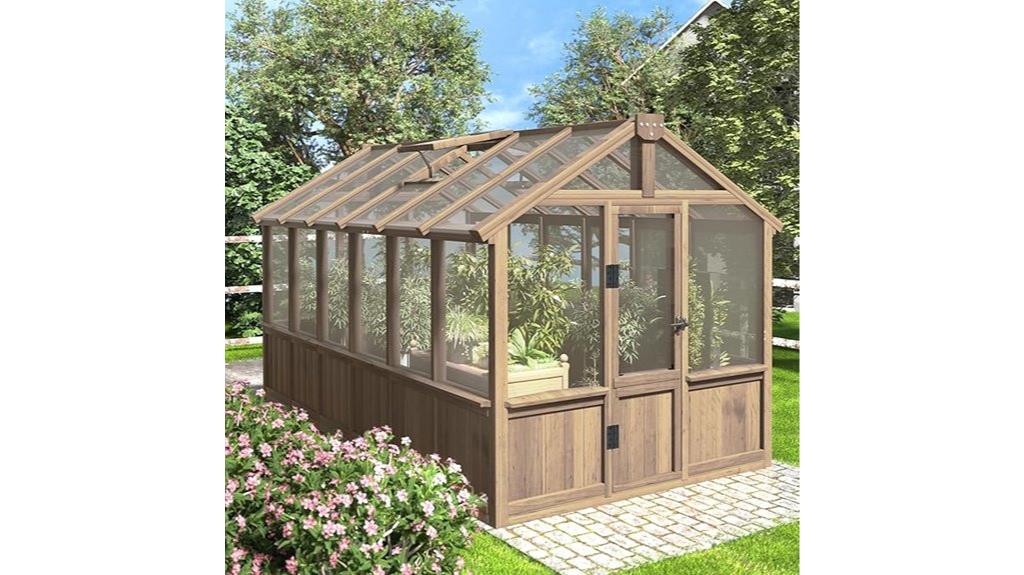
If you're looking for a greenhouse that combines durability with ample growing space, the Yardenaler 6×12 FT Greenhouse Kit is an excellent choice. With its sturdy fir wood frame and 6MM thick polycarbonate panels, it withstands various weather conditions while ensuring your plants receive ideal light and UV protection. The adjustable roof vent lets me balance airflow and temperature, making it perfect for all my gardening needs. Plus, the lockable door provides security for my plants and tools. With a 4.8-star rating, it's well-loved by users for its quality and ease of assembly, making it a top pick for my outdoor space.
Best For: Gardeners looking for a durable and spacious greenhouse to cultivate plants in various weather conditions.
Pros:
- Sturdy Construction: Made from fir wood and reinforced for stability, ensuring longevity in different weather.
- High Light Transmission: 6MM thick polycarbonate panels provide excellent UV protection and light for plants.
- Easy Assembly: Users report a straightforward assembly process, making it accessible for all skill levels.
Cons:
- Roof Vent Design: Some users have expressed concerns regarding the effectiveness of the roof vent.
- Shipping Issues: The product ships in five boxes and may not arrive all at once, potentially leading to delays.
- Weight: At 317 pounds, it may require assistance for setup and placement.
Macrout Cold Frame Greenhouse with Adjustable Shelves
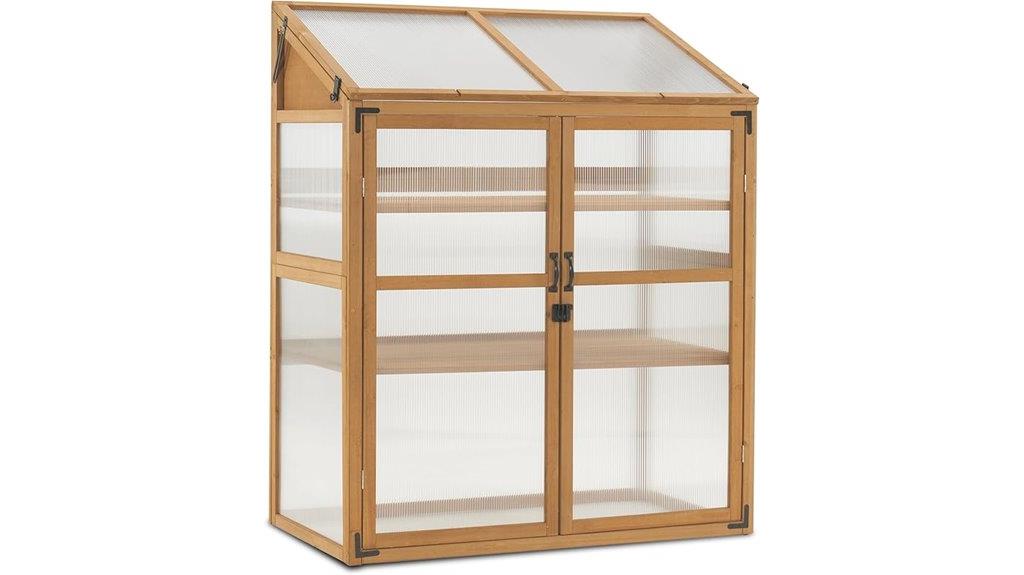
For anyone looking to nurture a variety of plants, the Macrout Cold Frame Greenhouse with Adjustable Shelves stands out as an ideal choice. Its large wooden cabinet design, measuring 44.5 x 24.8 x 55.4 inches, is perfect for both outdoor and indoor use. I love the two adjustable shelves, which let me customize the height for different plant types. The openable roof with side bolts guarantees proper ventilation, keeping my plants healthy. Made from high-quality fir wood, its polished medium brown finish adds a rustic charm. Plus, the reinforced metal brackets provide extra stability, making it a safe option for my gardening needs.
Best For: Garden enthusiasts looking for a versatile and stylish greenhouse to nurture a variety of plants indoors and outdoors.
Pros:
- Adjustable Shelves: Customizable height allows for accommodating different plant types and sizes.
- Ventilation: Openable roof design ensures proper airflow, promoting healthy plant growth.
- Sturdy Construction: Made from high-quality fir wood and reinforced with metal brackets for enhanced stability and safety.
Cons:
- Size Limitations: May not be suitable for larger plants or extensive gardening needs due to its dimensions.
- Assembly Required: The product may require some assembly, which could be challenging for some users.
- Wood Maintenance: The wooden material may need periodic maintenance to prevent weathering over time.
Factors to Consider When Choosing Bonsai Greenhouse Designs

When I'm choosing a bonsai greenhouse design, I always consider key factors that can impact my trees' health. Climate control, space, materials, and ventilation play a huge role in creating the right environment. Plus, I can't forget about lighting and shade options to guarantee my bonsai thrive.
Climate Control Requirements
Considering the specific needs of bonsai trees, effective climate control is essential in any greenhouse design. I've found that maintaining temperatures between 60°F and 75°F during the growing season is vital for their health. Proper ventilation is key to preventing overheating and ensuring good air circulation, which helps avoid fungal diseases. During colder months, I recommend using thermostatically controlled heaters to keep the temperature ideal year-round. Humidity levels should ideally be between 40% and 60%, so I often use humidifiers or misting systems, especially in drier climates. Additionally, I make sure to incorporate shading options like shade cloths or adjustable vents to protect my bonsai from excessive sunlight and heat, preventing sunburn and dehydration.
Space and Layout
After establishing effective climate control, the next step is to focus on the space and layout of your bonsai greenhouse. I recommend evaluating the available space to guarantee it accommodates the number of bonsai trees you plan to cultivate, along with enough room for movement and maintenance. Position the greenhouse to maximize sunlight exposure, as proper light is essential for healthy growth. Incorporating adjustable shelving can help you utilize vertical space efficiently, organizing trees by height and growth stage. Don't forget about ventilation; adequate airflow prevents excessive humidity and potential mold. Finally, consider creating specialized zones within the greenhouse to cater to the diverse needs of various bonsai species, making sure they thrive in the best conditions possible.
Material Selection Considerations
Choosing the right materials for your bonsai greenhouse is vital for creating an environment that promotes healthy growth. I recommend polycarbonate panels, as they provide high light transmittance and better heat retention than glass, ensuring ideal conditions for your bonsai trees. If you prefer a more natural look, wood frames can add aesthetic appeal and insulation, but remember to treat them to resist moisture and prevent rot. Aluminum frames are another great option; they're lightweight, rust-resistant, and durable in various weather conditions. Also, consider the thickness of your greenhouse walls—materials with a thickness of 4mm or more enhance thermal insulation, essential for stable temperatures in colder climates. Make sure your chosen materials allow for proper ventilation, too!
Ventilation and Airflow
While maintaining the right humidity and temperature is essential for bonsai health, proper ventilation and airflow in your greenhouse play an equally important role. I've learned that good ventilation prevents excess humidity, which can lead to mold and diseases that threaten my trees. Adjustable vents or openings are crucial; they give me the control to customize airflow and regulate temperature. I've found that placing vents at different heights promotes effective circulation, ensuring fresh air and necessary carbon dioxide for photosynthesis. Additionally, incorporating features like openable roofs can enhance airflow, especially during warmer weather while still maintaining humidity control. Remember, a well-ventilated greenhouse is key to promoting healthy growth in your bonsai collection.
Lighting and Shade Options
Good ventilation and airflow set the stage for another vital aspect of bonsai greenhouse design: lighting and shade options. Proper lighting is essential since bonsai trees need ample light to thrive. When placing your greenhouse, consider its location to maximize natural sunlight exposure. I also find that incorporating shade cloths or adjustable panels can help regulate temperature and prevent leaf burn during intense sun, especially for sensitive species. In cooler climates, good insulation and light control can extend the growing season. Combining artificial grow lights with natural light guarantees your bonsai receive enough photoperiod during shorter days. Finally, using reflective surfaces within the greenhouse enhances light distribution, making sure all your bonsai plants flourish with the right illumination.
Frequently Asked Questions
What Materials Are Best for Bonsai Greenhouse Construction?
When I think about the best materials for bonsai greenhouse construction, I lean towards polycarbonate panels for their insulation and durability. I also love using aluminum frames since they're lightweight and resistant to rust. For the foundation, treated wood works well to support the structure. I've found that these materials not only protect my bonsais but also create a cozy environment for them to thrive. It's all about giving them the best care possible!
How Can I Control Humidity Levels in My Bonsai Greenhouse?
I've faced the challenge of controlling humidity levels in my bonsai greenhouse, and let me tell you, it's essential for healthy plants. To keep things just right, I use a combination of misting systems and humidity trays. I also monitor the humidity with a hygrometer, adjusting ventilation as needed. It's a balancing act, but the results are worth it—my bonsais thrive, and I can't help but feel proud of my little green masterpieces!
What Are the Best Lighting Options for a Bonsai Greenhouse?
When I set up my bonsai greenhouse, I found that lighting is essential for healthy growth. I prefer using LED grow lights because they're energy-efficient and provide the full spectrum my bonsai needs. Natural light is great, but I supplement it with these lights during cloudy days or winter months. I keep the lights on for about 12-16 hours daily, ensuring my plants thrive regardless of the season. It's made a big difference!
How Often Should I Water Bonsai Plants in a Greenhouse?
When it comes to watering bonsai plants in a greenhouse, I find it essential to check the soil moisture regularly. Generally, I water them when the top inch of soil feels dry, which can be every few days to once a week, depending on the humidity and temperature. I always make sure not to overwater, as that can lead to root rot. Observing my plants helps me adjust my routine as needed.
Can I Grow Other Plants Alongside Bonsai in the Same Greenhouse?
Absolutely, I can grow other plants alongside my bonsai in the same greenhouse! It's like hosting a fabulous dinner party where everyone gets along! I've mixed herbs, small flowers, and even tropical plants, creating a lush paradise. Just make sure they share similar light and water needs. I've found that harmony in plant choices enhances the beauty of my greenhouse, making it an oasis of green joy that never fails to impress!
Conclusion
In the world of bonsai, choosing the right greenhouse is like finding the perfect canvas for an artist. I remember the first time I nurtured a tiny maple tree—I watched it transform over the seasons, each leaf a brushstroke in a living masterpiece. Just like that tree, your bonsai will thrive in the right environment. So, invest in a greenhouse that inspires you, and watch your miniature landscapes flourish into stunning works of art. Happy gardening!
